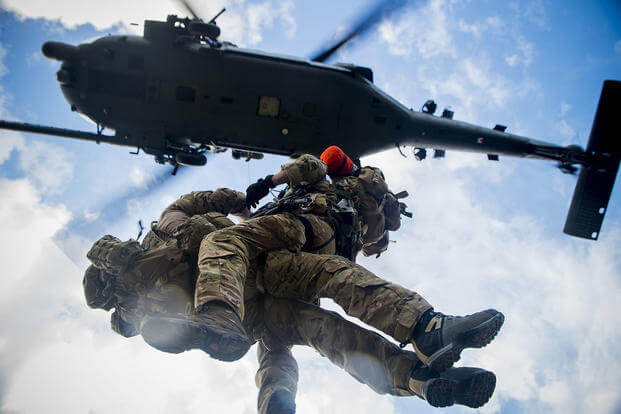The Air Force will consolidate eight locations it uses to train its battlefield airmen into "three or four," the head of Air Education Training Command said Monday.
"This is a very important piece of our warfighting capability," Lt. Gen. Darryl Roberson told reporters during a briefing at the Air Force Association's annual Air, Space & Cyber Conference outside Washington, D.C.
"Modernization and recapitalization for our battlefield airmen is occurring across five strategic pillars" -- recruiting; manpower and leadership; equipment; infrastructure; and curriculum, he said.
The current centers are scattered around seven states, forcing airmen to move back and forth too much, Roberson said. "Every time we need to send an airman [somewhere different], we lose a week of training."
The consolidation, which could take more than a year, is designed to provide improved infrastructure with enhanced aquatic training for combat rescue and other missions.
"Right now, we do not have an adequate pool, aquatic training facility," Roberson said. "We're doing it, but when we consolidate to the three or four, we're going to be able to hopefully build a new aquatic system."
The service is conducting environmental assessment surveys for the following eight locations: Eglin Air Force Base, Patrick AFB and Hurlburt Field in Florida; Joint Base San Antonio, Texas; Keesler AFB, Mississippi; Little Rock AFB, Arkansas; Shaw AFB, South Carolina; and Vandenberg AFB, California.
The Air Force in June stood up a Battlefield Airman Group dedicated to "train the service's ground component at Joint Base San Antonio-Lackland." The unit is designed to address a "growing need for 'fifth-generation warriors' who integrate air and ground operations on the joint battlefield," according to an Air Force release.
The group replaced the 342nd Training Squadron, which incorporated entry-level training for pararescue, combat control, special operations weather, and tactical air control party airmen.
Training Stress
A tragedy at the 342nd in April has led the Air Force to re-evaluate the battlefield program and how it responds to airmen who want to quit.
On April 8, Tech. Sgt. Steven D. Bellino shot and killed Lt. Col. William Schroeder, the squadron commander, and then took his own life.
Bellino, 41, allegedly quit the program after a contested swim test last year. A few days later, he went absent without official leave.
After he was charged with going AWOL, Bellino sought an administrative discharge including nonjudicial punishment. However, the Air Force had yet to process the discharge, according to Daniel Conway, his attorney at the time.
The events that took place that day are still under investigation.
"We have been engaged since the moment and even before that happened," Roberson said in regard to the shooting. "Training is very tough. It's very demanding. There's no doubt. And we immediately did a quick, 'What do we think happened here, and what can we do to try to make sure this doesn't happen again?' "
Roberson said changes to the battlefield program are constantly being evaluated to avoid future misfortune.
For example, "when a member of the battlefield airman training system declares that they want to quit or stop their … training, there was in place by law a process that everyone had to go through. That process, we think, could be done a little bit quicker, more smoothly," which has now been amended through additional policies, he said.
"We have a process, we have a system; it's law based. There's legal pieces, and it just takes time," Roberson said. "What we're trying to do is expedite, help that, make it smoother and faster, with commander input … when these kind of things happen."
Roberson added there will be other, streamlined processes added to better assist airmen who have previously served in sister services. Bellino had served in the Army prior to joining the Air Force.
-- Oriana Pawlyk can be reached at oriana.pawlyk@military.com. Follow her on Twitter at@Oriana0214.

























